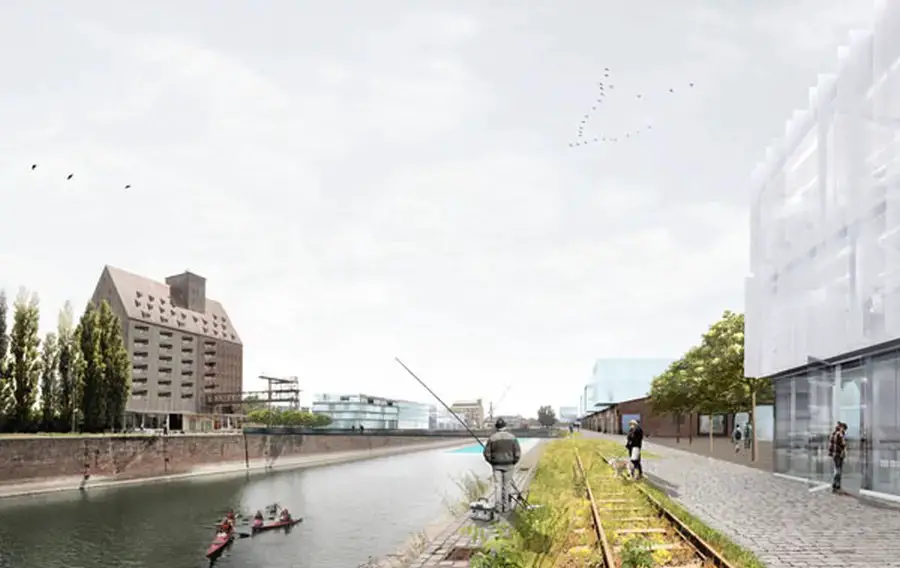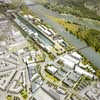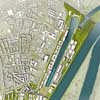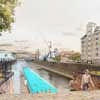Magdeburg Science Quarter building, central German Science Quarter architecture, New neighbourhood design
Magdeburg Science Quarter Masterplan, Germany
German Masterplan design by SMAQ
30 Sep 2011
Location: Magdeburg, central Germany
Masterplan Magdeburg Science Quarter Completed
Magdeburg Science Quarter
The city of Magdeburg in Germany is developing a new Science Quarter in order to promote itself as a research, education, and business hub. This development project is currently one of the most important urban planning focus areas in Magdeburg. The aim is to bring existing science and research facilities together in order to develop a neighbourhood with room for expansion.
This new neighbourhood will be anchored at the historic trading harbour, in direct association with the river landscape of the Elbe and close to the city centre. It will be attractively and vibrantly occupied with residential, recreational, and cultural uses as a base for innovation and knowledge transfer. As the winners of the international urban design and open space planning competition for the science quarter in 2010, the Berlin based office SMAQ prepared the master plan with HL landscape architects. The planning phase for the 48-hectare site is now completed.
The master plan provides the basis for the development of the science quarter in the area surrounding the historic trading harbour of Magdeburg-Neustadt. It builds an interconnection between the Otto-von-Guericke University and the research institutes at Askanischer Platz by proposing a strong common entry into the neighbourhood. In addition to the consolidation and redevelopment of the site for scientific and commercial uses, housing, recreational spaces, cultural uses, and utility facilities are foreseen. These additional resources will provide space for about 4,000 people to work and 600 people to live within the planned science quarter.
This conversion project is distinct in its proposed integration of a science district into the fragmented urban structure through spatial and urban means – despite the infrastructural barrier of the 5 lane Sandtorstraße, which was built post-reunification. The new science district will formulate interfaces with Alte Neustadt as well as with the cultural and recreational area at the northern end of the harbour. This will not only bring the city to the Elbe River, but will also situate the cultural landmark of the historic trading harbour as part of the lived urban space of the city.
The master plan for the science quarter makes a significant contribution to sustainable urban development. Inner city land reserves will be developed with a higher building density and connected to nearby recreation areas along the river bank. The science district will promote the “alternative mobility” of pedestrians and bicyclists. Ecological strategies are integrated into the design through the use of local and sturdy ruderal vegetation in the open spaces. Water management will be improved through the integration of proper surfaces and drainage into the landscape.
Three motifs characterize the master plan: visibility, communication and permeability.
Visibility – the creation of an internally and externally apparent science quarter. In the heterogeneous urban context, the science quarter will be evident and distinct through a coherent language of building and public space design. This structural and spatial language will freely unfold from the interaction of old and new. The new buildings will be height-regulated to set the scene for the distinctive industrial silo buildings. The neighbourhood entrance at Sandtorplatz will be framed by three high-rise buildings which will visually anchor the science quarter in the urban structure.
Communications – the development of public spaces in the science district. Communication will be improved through planned programmatic adjacencies, networking interests together, focusing movements towards nodes, and designing high quality public spaces. The spatial system and communication backbone of the science quarter is formed by linking public spaces together. A spatial sequence leads from the university campus and the square on the eastern side of Sandtorstrasse across the entry at Sandtorplatz, to the Charles de Gaulle Square at the harbour and to the Elbe. Along the harbour, a sequence unfolds along the promenade leading out to the new silo square and, further out, to the lift bridge next to the historic steamboat “Gustav Zeuner.”
Permeability – the integration of the science quarter is characterized by opening with and merging with the urban context and the landscape. The new science quarter will connect the city with the river. The new Sandtorplatz, and entry into the science quarter, creates the most important link between Alte Neustadt and Wittenberg Platz with the Elbe balcony on the riverside. Public paths from the harbour to the Elbe and a new pedestrian bridge over the harbour overcome ingrained movement barriers on the site. The sports and recreation areas developed along the international Elbe River Bike Path link the science quarter with the city centre downstream and natural landscape areas upstream.
Masterplan Magdeburg Science Quarter images / information from SMAQ
SMAQ – architecture urbanism research, are based in Berlin, Germany
Location: Magdeburg, Germany, western Europe
Architecture in Germany
German Architecture
German Architectural Designs – chronological list
Another Magdeburg building on e-architect:
Open-Air-Library Magdeburg
KARO*, Leipzig & Architektur+Netzwerk, Magdeburg
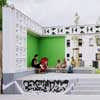
photo : Anja Schlamann
Magdeburg library building
Heilbronn — A City Redesigns Itself, Baden-Württemberg, Southwest Germany
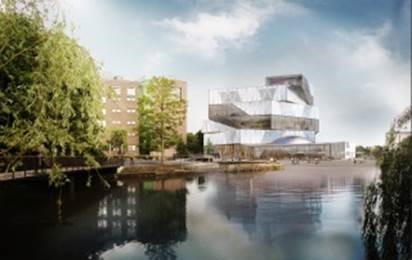
image © Sauerbruch Hutton
BUGA Bundesgartenschau Heilbronn 2019 Buildings
‘Behaviour Morphe’ light mapping projection, Karlsruhe, Baden-Württemberg, Southwest Germany
Design: Zaha Hadid Architects
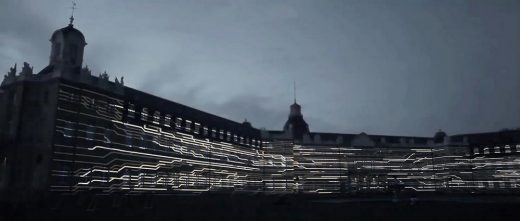
image Courtesy architecture office
‘Behaviour Morphe’ light mapping projection in Karlsruhe
Heidelberg Congress Center, Heidelberg, Baden-Württemberg
Design: Degelo Architekten
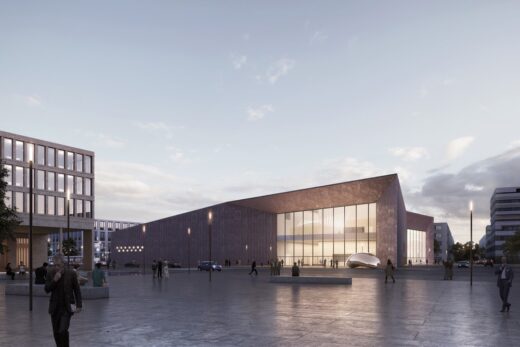
photo : Degelo Architekten
Heidelberg Congress Center
Comments / photos for the Magdeburg Science Quarter design by SMAQ in central Germany on the Elbe River page welcome.

